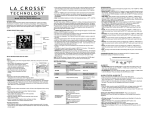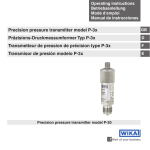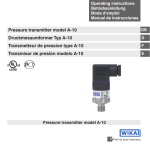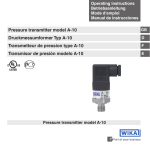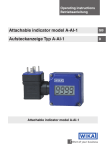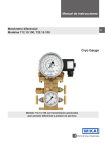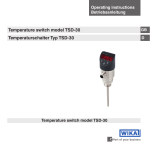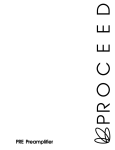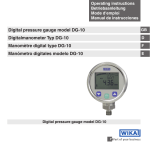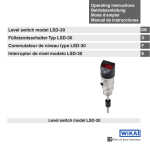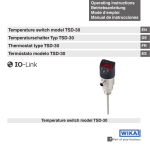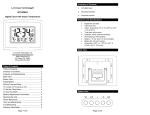Download Präzisions-Druckmessumformer Typen P-30, P-31 - Emet
Transcript
Operating instructions Betriebsanleitung Precision pressure transmitter models P-30, P-31 Präzisions-Druckmessumformer Typen P-30, P-31 Precision pressure transmitter model P-30 GB D GB Operating instructions models P30, P-31 D Betriebsanleitung Typen P30, P-31 Page 3 - 24 Seite 25 - 46 Prior to starting any work, read the operating instructions! Keep for later use! Vor Beginn aller Arbeiten Betriebsanleitung lesen! Zum späteren Gebrauch aufbewahren! 2 WIKA operating instructions precision pressure transmitter model P-30, P-31 11473500.03 08/2011 GB/D © 2011 WIKA Alexander Wiegand SE & Co. KG All rights reserved. / Alle Rechte vorbehalten. WIKA® is a registered trademark in various countries. WIKA® ist eine geschützte Marke in verschiedenen Ländern. Contents Contents GB 1. General information 4 2. Safety 6 3. Specifications 9 4. Design and function 13 5. Transport, packaging and storage 14 6. Commissioning, operation 14 7. Maintenance and cleaning 21 8. Faults 21 9. Dismounting, return and disposal 23 11473500.03 08/2011 GB/D ?? Appendix 1: EC declaration of conformity for models P-30, P-31 24 Declarations of conformity can be found online at www.wika.com. WIKA operating instructions precision pressure transmitter models P-30, P-31 3 1. General information 1. General information ■■ The pressure transmitter described in the operating instructions has been designed and manufactured using state-of-the-art technology. All components are subject to stringent quality and environmental criteria during production. Our management systems are certified to ISO 9001 and ISO 14001. ■■ These operating instructions contain important information on handling the pressure transmitter. Working safely requires that all safety instructions and work instructions are observed. ■■ Observe the relevant local accident prevention regulations and general safety regulations for the pressure transmitter's range of use. ■■ The operating instructions are part of the product and must be kept in the immediate vicinity of the pressure transmitter and readily accessible to skilled personnel at any time. ■■ Skilled personnel must have carefully read and understood the operating instructions prior to beginning any work. ■■ The manufacturer's liability is void in the case of any damage caused by using the product contrary to its intended use, non-compliance with these operating instructions, assignment of insufficiently qualified skilled personnel or unauthorised modifications to the pressure transmitter. ■■ The general terms and conditions, contained in the sales documentation, shall apply. ■■ Subject to technical modifications. ■■ Further information: - Internet address: - Relevant data sheet: - Application consultant: 4 www.wika.de / www.wika.com PE 81.54 Tel.: (+49) 9372/132-8976 Fax: (+49) 9372/132-8008976 E-Mail: [email protected] WIKA operating instructions precision pressure transmitter models P-30, P-31 11473500.03 08/2011 GB/D GB 1. General information Explanation of symbols WARNING! ... indicates a potentially dangerous situation that can result in serious injury or death, if not avoided. CAUTION! ... indicates a potentially dangerous situation that can result in light injuries or damage to equipment or the environment, if not avoided. Information … points out useful tips, recommendations and information for efficient and trouble-free operation. CAUTION! ... indicates a potentially dangerous situation that can result in burns, caused by hot surfaces or liquids, if not avoided. Abbreviations 2-wire 11473500.03 08/2011 GB/D 3-wire U+ US+ Two of the connection lines are used for the voltage supply. The measurement signal also provides the supply current. Two of the connection lines are used for the voltage supply. One connection line is used for the measurement signal. Positive power terminal Negative power terminal Positive measurement terminal WIKA operating instructions precision pressure transmitter models P-30, P-31 5 GB 2. Safety 2. Safety WARNING! Before installation, commissioning and operation, ensure that the appropriate pressure transmitter has been selected in terms of measuring range, design and specific measuring conditions. Non-observance can result in serious injury and/or damage to the equipment. GB WARNING! Open the connections only after the system has been depressurised. Prior to opening the instrument, disconnect it from the mains. Always operate the pressure transmitter within the overpressure limit. Observe the working conditions in accordance with chapter 3 "Specifications". For the application of the pressure transmitter in connection with aggressive / corrosive media and for avoiding mechanical damages, see chapter 3 „Specifications“. ■■ ■■ ■■ ■■ ■■ Further important safety instructions can be found in the individual chapters of these operating instructions. 2.1 Intended use The pressure transmitter is used to convert pressure into an electrical signal. The technical specifications contained in these operating instructions must be observed. Improper handling or operation of the pressure transmitter outside of its technical specifications requires the instrument to be taken out of service immediately and inspected by an authorised WIKA service engineer. The manufacturer shall not be liable for claims of any type based on operation contrary to the intended use. 6 WIKA operating instructions precision pressure transmitter models P-30, P-31 11473500.03 08/2011 GB/D The pressure transmitter has been designed and built solely for the intended use described here and may only be used accordingly. 2. Safety 2.2 Personnel qualification WARNING! Risk of injury should qualification be insufficient! Improper handling can result in considerable injury and damage to equipment. The activities described in these operating instructions may only be carried out by skilled personnel who have the qualifications described below. Skilled personnel Skilled personnel are understood to be personnel who, based on their technical training, knowledge of measurement and control technology and on their experience and knowledge of country-specific regulations, current standards and directives, are capable of carrying out the work described and independently recognising potential hazards. Special operating conditions require further appropriate knowledge, e.g. of aggressive media. 2.3 Special hazards 11473500.03 08/2011 GB/D WARNING! For hazardous media such as oxygen, acetylene, flammable or toxic gases or liquids, and refrigeration plants, compressors, etc., in addition to all standard regulations, the appropriate existing codes or regulations must also be followed. WARNING! Residual media in dismounted pressure transmitters can result in a risk to persons, the environment and equipment. Take sufficient precautionary measures. WARNING! When touching the pressure transmitter, please note that the surfaces of the instrument components can become hot during operation. WIKA operating instructions precision pressure transmitter models P-30, P-31 7 GB 2. Safety 2.4 Labelling / Safety marks Pin assignment Model Measuring range P# Product No. S# Serial No. Output signal Power supply Accuracy If the serial number becomes illegible (e.g. due to mechanical damage or overpainting), traceability will no longer be possible. Explanation of symbols General danger symbol CE, Communauté Européenne Instruments bearing this mark comply with the relevant European directives. Voltage DC 8 WIKA operating instructions precision pressure transmitter models P-30, P-31 11473500.03 08/2011 GB/D GB Product label 3. Specifications 3. Specifications 3.1 Measuring ranges Relative pressure bar psi 0 ... 0.25 0 ... 0.4 0 ... 0.6 0 ... 400 0 ... 600 0 ... 1000 0 ... 10 0 ... 5 0 ... 160 0 ... 800 0 ... 1 0 ... 1.6 0 ... 2.5 0 ... 4 0 ... 6 0 ... 15 0 ... 25 0 ... 30 0 ... 50 0 ... 60 0 ... 100 0 ... 1500 0 ... 2000 0 ... 3000 0 ... 5000 0 ... 10000 0 ... 0.4 0 ... 0.6 0 ... 1 0 ... 1.6 0 ... 2.5 0 ... 4 0 ... 6 0 ... 10 0 ... 15 0 ... 25 0 ... 30 0 ... 50 0 ... 60 0 ... 100 0 ... 16 psi 0 ... 0.25 0 ... 200 0 ... 1000 1) 0 ... 160 0 ... 200 0 ... 160 0 ... 200 0 ... 5 0 ... 25 0 ... 10 Absolute pressure bar GB 0 ... 250 0 ... 40 0 ... 300 Vacuum and +/- measuring range bar psi -1 ... 0 -30 inHG ... 0 -1 ... 0.6 -30 inHG ... 15 -1 ... 1.5 -30 inHG ... 30 0 ... 60 0 ... 400 -1 ... 3 -30 inHG ... 60 -1 ... 5 0 ... 100 0 ... 160 0 ... 500 0 ... 600 -1 ... 9 0 ... 250 0 ... 750 -1 ... 15 -30 inHG ... 100 -30 inHG ... 160 -30 inHG ... 200 11473500.03 08/2011 GB/D 1) Applies only to P-30 Overpressure limit ■■ 3 times: up to 16 bar ■■ 2 times: from 16 bar ■■ 1.5 times: 0 ... 1000 psi, 0 ... 1500 psi, 0 ... 10000 psi Vacuum resistance: yes WIKA operating instructions precision pressure transmitter models P-30, P-31 9 3. Specifications 3.2 Output signal Value 4 ... 20 mA Voltage (3-wire) DC 0 ... 10 V 4 ... 20 mA Current (3-wire) - USB Current (2-wire, 3-wire): Voltage (3-wire): DC 0 ... 5 V DC 1 ... 5 V DC 0.5 ... 4.5 V - CANopen Load in Ω 0 ... 20 mA ≤ (power supply - 9 V) / 0.02 A > Umax / 1 mA 3.3 Voltage supply Power supply DC 9 ...30 V, DC 14 ... 30 V (for voltage output DC 0 ... 10 V) Measuring rate 3-wire and CANopen: 1 ms 2-wire 2 ms USB: 3 ms Warm-up time < 10 min Total current consumption Current output (2-wire): Current output (3-wire): Voltage output (3-wire): USB: CANopen: 10 max. 25 mA max. 45 mA max. 10 mA 40 mA 60 mA WIKA operating instructions precision pressure transmitter models P-30, P-31 11473500.03 08/2011 GB/D GB Signal type Current (2-wire) 3. Specifications 3.4 Accuracy Non-linearity (IEC 61298-2) ≤ ± 0.04 % of span BFSL GB Accuracy at room temperature Standard Option Accuracy class ≤ ± 0.1 % of span 1) ≤ ± 0.05 % of span 1) 2) 1) Including non-linearity, hysteresis, zero-point and full scale deviations (corresponds to measured error per IEC 61298-2). Calibrated in vertical mounting position with process connection facing downwards. 2) Not possible with vacuum and +/- measuring ranges, as well as measuring ranges ≤ 0.4 bar. Temperature error -20 ... +10 °C: ≤ ± 0.2 % / 10 K 10 ... 60 °C: no additional error (actively compensated) 60 ... 80 °C: ≤ ± 0.2 % / 10 K Long-term drift per year ≤ ± 0.1 % of span 11473500.03 08/2011 GB/D Total error band (10 ... 60 °C) ≤ ± 0.1 % of span Adjustment and recalibration Calibration via software "EasyCom 2011" Zero point: -5 ... +20 % of span Span: -5 ... +20 % of span WIKA operating instructions precision pressure transmitter models P-30, P-31 11 3. Specifications 3.5 Reference conditions (IEC 61298-1) 15 ... 25 °C 950 ... 1050 mbar 45 ... 75 % relative Process connection lower mount (LM) DC 24 V see output signals as required 3.6 Operating conditions Mechanics Vibration resistance: Shock resistance: Service life: Free fall: 10 g (IEC 60068-2-6, under resonance) 200 g (IEC 60068-2-27, mechanical) 10 million load cycles 1m Temperatures Compensated temperature range: Medium: Ambient: Storage: -20 ... +80 °C -20 ... +105 °C -20 ... +80 °C -40 ... +85 °C 3.7 Electrical safety Short-circuit resistance: S+ vs. 0V CAN-High / CAN-Low vs. U+ / 0V Reverse polarity protection: U+ vs. 0V Overvoltage protection: DC 36 V Insulation voltage: DC 500 V 12 WIKA operating instructions precision pressure transmitter models P-30, P-31 11473500.03 08/2011 GB/D GB Temperature: Atmospheric pressure: Humidity: Nominal position: Power supply: Load: Mounting position: 3. Specifications / 4. Design and function 3.8 Materials Wetted parts Stainless steel Sealing material used GB Non-wetted parts Stainless steel (additionally Elgiloy® for measuring ranges > 25 bar) 3.9 Approvals, directives and certificates CE conformity EMC directive: Pressure equipment directive: ROHS conformity: 1) Not with bayonet connector 2004/108/EC EN 61326 emission (group 1, class B) and interference immunity (industrial application) 97/23/EC Yes 1) 11473500.03 08/2011 GB/D 4. Design and function 4.1 Description By means of a sensor element and by applying power, the prevailing pressure is converted into an amplified standardised electrical signal via the deformation of a diaphragm. This electrical signal varies in proportion to the pressure and can be evaluated accordingly. 4.2 Scope of delivery Cross-check scope of delivery with the delivery note. Flush design (P-31) with pre-mounted sealings and protection cap. For model P-31, the sealing ring is included in the delivery. WIKA operating instructions precision pressure transmitter models P-30, P-31 13 5. Transport, packaging and storage / 6. Commissioning, ... 5. Transport, packaging and storage 5.1 Transport Check the instrument for any damage that may have been caused during transportation. Obvious damage must be reported immediately. 5.2 Packaging Do not remove packaging until just before mounting. Keep the packaging as it will provide optimum protection during transport (e.g. change in installation site, sending for repair). Keep the protection cap of the process connection for later transport or storage. 5.3 Storage Permissible conditions at the place of storage: ■■ Storage temperature: -20 ... +80 °C ■■ Humidity: 45 ... 75 % relative humidity (no condensation) WARNING! Before storing the pressure transmitter (following operation), remove any residual media. This is of particular importance if the medium is hazardous to health, e.g. caustic, toxic, carcinogenic, radioactive, etc. 6. Commissioning, operation CAUTION! Prior to commissioning, the pressure transmitter must be subjected to a visual inspection. ■■ Check the diaphragm for any visible damage, since this is a safety-relevant component. ■■ Leaking fluid is indicative of damage. ■■ Only use the pressure transmitter if it is in perfect condition with respect to safety. 14 WIKA operating instructions precision pressure transmitter models P-30, P-31 11473500.03 08/2011 GB/D GB 6. Commissioning, operation 6.1 Making the mechanical connection Required tool: Open-ended spanner (spanner width 27 or 41) GB ■■ With flush process connections, remove the protection cap not until shortly before mounting. During installation, ensure that the diaphragm is not damaged. ■■ During mounting, make sure that the sealing faces at the pressure transmitter and the measuring point are clean and undamaged. ■■ Only ever screw in, or unscrew, the instrument via the spanner flats. Never max. 10 Nm use the case as a working surface. ■■ The correct torque depends on the dimensions of the process connection and the sealing used (form/material). ■■ When screwing in, avoid any jamming of the threads. ■■ For information on tapped holes and welding sockets, see Technical Information IN 00.14 at www.wika.com. 11473500.03 08/2011 GB/D Types of sealing Parallel threads per EN 837 Tapered threads NPT, R and PT per DIN 3852-E 1 1 WIKA operating instructions precision pressure transmitter models P-30, P-31 15 6. Commissioning, operation For further information on sealings see WIKA data sheet AC 09.08 or under www.wika.com. Models P-30 and P-31 are high-quality precision measuring instruments. Installationrelated influences (e.g. position dependence, tightening torque) must be eliminated by correcting the zero point in the application or via the software "EasyCom". Thus an optimum measuring accuracy of the overall system is ensured. Fitting a DIN 175301-803 angular connector (D) Mounting hole (2) (1) (3) (4) (5) Line connector (female) 1. Loosen the screw (1). 2. Loosen the cable gland (2). 3. Pull the angle housing (5), with the terminal block (6) inside, away from the instrument. 4. Via the mounting hole (D), lever the terminal block (6) out of the angle housing (5). Do not try to push the terminal block (6) out using the screw hole (1) or the cable gland (2), otherwise the sealing of the angle housing could be damaged. 16 (6) Sealing Instrument connector (male), case with process connection WIKA operating instructions precision pressure transmitter models P-30, P-31 11473500.03 08/2011 GB/D GB Correct sealing of the process connections with parallel threads 1 must be made using suitable flat gaskets, sealing rings or WIKA profile sealings. The sealing of tapered threads (e.g. NPT threads) is made by providing the thread with additional sealing material such as, for example, PTFE tape (EN 837-2). 6. Commissioning, operation 5. Select a conductor with an outer diameter matched to the angle housing's cable gland. Slide the cable through the cable gland (2), ring (3), sealing (4) and angle housing (5). 6. Connect the cable ends to the appropriate connection terminals on the terminal block (6) (see table "Connection diagrams"). 7. Press the angle housing (5) onto the terminal block (6). 8. Tighten the cable gland (2) around the cable. Make sure that the sealings are not damaged and that the cable gland and sealings are assembled correctly in order to ensure ingress protection. 9. Place the flat, square gasket over the pressure transmitter's connection pins. 10. Slide the terminal block (6) onto the pressure transmitter's connection pins. 11. Secure the angle housing (5) and terminal block (6) to the pressure transmitter with the screw (1). 6.2 Making the electrical connection ■■ The instrument must be earthed via the process connection. ■■ Select a cable diameter that matches the cable gland of the connector. Make sure that the cable gland of the mounted connector has a tight fit and that the sealings are present and undamaged. Tighten the threaded connection and check that the seal is correctly seated, in order to ensure a tight seal. 11473500.03 08/2011 GB/D ■■ For cable outlets, make sure that no moisture enters at the cable end. WIKA operating instructions precision pressure transmitter models P-30, P-31 17 GB 6. Commissioning, operation Connection diagrams Assignment 2-wire 3-wire U+ 0V 1 1 S+ 2 2 3 Bayonet connector Assignment 2-wire 3-wire U+ S+ B B C CANopen M12 x 1 (5-pin) Assignment U+ 1 1 0V 3 3 S+ 4 Assignment 2-wire 3-wire U+ 3 3 0V 1 4 S+ 1 Cable outlet unshielded UB+ UB- Shield CANHigh 2 3 1 4 18 2-wire 3-wire Circular connector M16 x 0.75 (5-pin) 0V A A Assignment CANLow 5 Assignment 2-wire 3-wire U+ brown brown 0V blue blue S+ black WIKA operating instructions precision pressure transmitter models P-30, P-31 11473500.03 08/2011 GB/D GB Circular connector M12 x 1 (4-pin) Angular connector DIN 175301-803 A 6. Commissioning, operation Specifications Description Ingress protection Angular connector DIN 175301-803 A IP 65 Circular connector M16 x 0.75 (5-pin) IP 67 Circular connector M12 x 1 (4-pin) Bayonet connector CANopen M12 x 1 (5-pin) USB GB IP 67 IP 67 IP 67 IP 67 IP 67 Cable outlet The stated ingress protection (per IEC 60529) only applies when plugged in using mating connectors that have the appropriate ingress protection. 6.3 Functional check The output signal must be proportional to the prevailing pressure. If this is not the case, this may indicate a damaged diaphragm. In this case, see chapter 8 "Faults". 6.4 Installation of the service interface Only required for analogue instruments 11473500.03 08/2011 GB/D Hardware requirement: ■■ Spare USB port ■■ USB adapter cable (order No.: 13193075 incl. software CD) ■■ Suitable voltage supply for the pressure transmitter System requirement: ■■ 32-bit operating system Microsoft® Windows® 2000, XP, Vista or Windows® 7 ■■ WIKA software EasyCom 2011 (CD containing software included with order No.: 13193075 or is available for download at www.wika.com) WIKA operating instructions precision pressure transmitter models P-30, P-31 19 6. Commissioning, operation Fitting of USB adapter cable 1. Switch the pressure transmitter to a depressurised state. 3. Connect the spade plug of the USB adapter cable to the instrument‘s USB connection 1 . 4. Connect the USB connector of the adapter cable to the free USB port of the computer. Sealing Clamping nut Instrument connector Sealing 1 Case with process connection 5. Connect pressure transmitter to power supply. 6.5 Commissioning of USB instruments For installing the driver, administrator rights are required. Connect the USB connector with a USB 2.0 port to the computer. Install the driver via the InstallWizard of the product software. For further operation the P-3x data logger software is available (for details see instruction manual P-3x data logger) ■■ Details on the interface protocol or the DLL (Dynamic Link Library) are available on the software CD and in the download section at www.wika.com. ■■ ■■ ■■ ■■ All files and documents are available for download at www.wika.com. 6.6 Commissioning of CANopen instruments ■■ Connect the CAN interface (e.g. PEAK PCAN-USB) to the PC and the pressure transmitter. ■■ Start the CAN software (e.g. PEAK PCAN-View). ■■ Make sure that the correct bit rate and node ID of the pressure transmitter is used. For further information see "Quick Start Guide" under "Additional Instructions". 20 WIKA operating instructions precision pressure transmitter models P-30, P-31 11473500.03 08/2011 GB/D GB 2. Remove the clamping nut and carefully pull out the instrument connector. Mating connector 7. Maintenance and cleaning / 8. Faults 7. Maintenance and cleaning 7.1 Maintenance This instrument is maintenance-free. Repairs must only be carried out by the manufacturer. GB 7.2 Cleaning CAUTION! ■■ Before cleaning, correctly disconnect the instrument from the pressure supply, switch it off and disconnect it from the mains. ■■ Clean the instrument with a moist cloth. ■■ Residual media in dismounted instruments can result in a risk to persons, the environment and equipment. Take sufficient precautionary measures. ■■ Do not use any pointed or hard objects for cleaning, since the diaphragm of the process connection must not be damaged. For information on returning the instrument see chapter 9.2 "Return". 8. Faults 11473500.03 08/2011 GB/D In the event of any faults, first check whether the pressure transmitter is mounted correctly, mechanically and electrically. Faults No output signal Causes Measures Cable break Check the through drilling No / wrong power supply or current pulse Correct the power supply WIKA operating instructions precision pressure transmitter models P-30, P-31 21 8. Faults Faults Constant output signal upon change in pressure No communication No cyclic transmission Signal span too small / drops Signal span varies / inaccurate Deviating zero point signal Wiring error Mechanical overload caused by overpressure Adjustment of node ID Transmission rate incorrect PDO mapping Transmission type incorrect Mechanical overload caused by overpressure Measures Observe the pin assignment Replace instrument; if it fails repeatedly, contact the manufacturer Check the configuration parameters Check the configuration parameters Replace instrument; if it fails repeatedly, contact the manufacturer Diaphragm damaged, e.g. due to Contact manufacturer and replace impacts, abrasive / aggressive medium; instrument corrosion at diaphragm / process connection; transmission medium missing Clean the sealing/sealing face, replace Sealing / sealing face damaged / soiled, sealing if applicable sealing does not have a tight fit, threads jammed EMC interference sources in the environ- Shield instrument; cable shield; remove ment; e.g. frequency converter source of interference Operating temperatures too high/low Observe the permissible temperatures Instrument not earthed Earth the instrument Strongly varying pressure of the process Damping; consulting by the manufacturer medium Operating temperature too high/low Permissible temperatures Other mounting position Correct the zero point via potentiometer or key pad or software Overpressure limit exceeded Observe the permissible overpressure limit If complaint is unjustified, we will charge you the complaint processing fees. 22 WIKA operating instructions precision pressure transmitter models P-30, P-31 11473500.03 08/2011 GB/D GB Causes No / wrong output signal 9. Dismounting, return and disposal CAUTION! If faults cannot be eliminated by means of the measures listed above, the instrument must be shut down immediately, and it must be ensured that pressure and/or signal are no longer present, and it must be prevented from being inadvertently put back into service. In this case, contact the manufacturer. If a return is needed, follow the instructions given in chapter 9.2 "Return". 9. Dismounting, return and disposal WARNING! Residual media in dismounted pressure transmitters can result in a risk to persons, the environment and equipment. Take sufficient precautionary measures. 9.1 Dismounting Only disconnect the pressure transmitter once the system has been depressurised! In order to protect the diaphragm of flush instruments, it is provided with a protection cap. 9.2 Return WARNING! Absolutely observe when shipping the pressure transmitter: All pressure transmitters delivered to WIKA must be free from any kind of hazardous substances (acids, leachate, solutions, etc.). 11473500.03 08/2011 GB/D When returning the pressure transmitter, use the original packaging or a suitable transport package. Enclose the completed returns form with the pressure transmitter. The returns form is available on the internet: www.wika.com / Service / Return 9.3 Disposal Incorrect disposal can put the environment at risk. Dispose of instrument components and packaging materials in an environmentally compatible way and in accordance with the country-specific waste disposal regulations. WIKA operating instructions precision pressure transmitter models P-30, P-31 23 GB Appendix 1: EC declaration of conformity for models P-30, P-31 24 WIKA operating instructions precision pressure transmitter models P-30, P-31 11473500.03 08/2011 GB/D GB Inhalt 11473500.03 08/2011 GB/D Inhalt 1. Allgemeines 26 2. Sicherheit 28 3. Technische Daten 31 4. Aufbau und Funktion 35 5. Transport, Verpackung und Lagerung 36 6. Inbetriebnahme, Betrieb 36 7. Wartung und Reinigung 43 8. Störungen 43 9. Demontage, Rücksendung und Entsorgung 45 Anlage 1: EG-Konformitätserklärung Typen P-30, P-31 46 Konformitätserklärungen finden Sie online unter www.wika.de. WIKA Betriebsanleitung Präzisions-Druckmessumformer Typen P-30, P-31 25 D 1. Allgemeines 1. Allgemeines ■■ Der in der Betriebsanleitung beschriebene Druckmessumformer wird nach den neuesten ■■ Diese Betriebsanleitung gibt wichtige Hinweise zum Umgang mit dem Druckmessumformer. Voraussetzung für sicheres Arbeiten ist die Einhaltung aller angegebenen Sicherheitshinweise und Handlungsanweisungen. ■■ Die für den Einsatzbereich des Druckmessumformers geltenden örtlichen Unfallverhütungsvorschriften und allgemeinen Sicherheitsbestimmungen einhalten. ■■ Die Betriebsanleitung ist Produktbestandteil und muss in unmittelbarer Nähe des Druckmessumformers für das Fachpersonal jederzeit zugänglich aufbewahrt werden. ■■ Das Fachpersonal muss die Betriebsanleitung vor Beginn aller Arbeiten sorgfältig durchgelesen und verstanden haben. ■■ Die Haftung des Herstellers erlischt bei Schäden durch bestimmungswidrige Verwendung, Nichtbeachten dieser Betriebsanleitung, Einsatz ungenügend qualifizierten Fachpersonals sowie eigenmächtiger Veränderung am Druckmessumformer. ■■ Es gelten die allgemeinen Geschäftsbedingungen in den Verkaufsunterlagen. ■■ Technische Änderungen vorbehalten. ■■ Weitere Informationen: - Internet-Adresse: - zugehöriges Datenblatt: - Anwendungsberater: 26 www.wika.de / www.wika.com PE 81.54 Tel.: (+49) 9372/132-8976 Fax: (+49) 9372/132-8008976 E-Mail: [email protected] WIKA Betriebsanleitung Präzisions-Druckmessumformer Typen P-30, P-31 11473500.03 08/2011 GB/D D Erkenntnissen konstruiert und gefertigt. Alle Komponenten unterliegen während der Fertigung strengen Qualitäts- und Umweltkriterien. Unsere Managementsysteme sind nach ISO 9001 und ISO 14001 zertifiziert. 1. Allgemeines Symbolerklärung WARNUNG! … weist auf eine möglicherweise gefährliche Situation hin, die zum Tod oder zu schweren Verletzungen führen kann, wenn sie nicht gemieden wird. VORSICHT! … weist auf eine möglicherweise gefährliche Situation hin, die zu geringfügigen oder leichten Verletzungen bzw. Sach- und Umweltschäden führen kann, wenn sie nicht gemieden wird. Information … hebt nützliche Tipps und Empfehlungen sowie Informationen für einen effizienten und störungsfreien Betrieb hervor. VORSICHT! … weist auf eine möglicherweise gefährliche Situation hin, die durch heiße Oberflächen oder Flüssigkeiten zu Verbrennungen führen kann, wenn sie nicht gemieden wird. Abkürzungen 2-Leiter 11473500.03 08/2011 GB/D 3-Leiter U+ US+ Zwei Anschlussleitungen dienen zur Spannungsversorgung. Der Speisestrom ist das Messsignal. Zwei Anschlussleitungen dienen zur Spannungsversorgung. Eine Anschlussleitung dient für das Messsignal. Positiver Versorgungsanschluss Negativer Versorgungsanschluss Positiver Messanschluss WIKA Betriebsanleitung Präzisions-Druckmessumformer Typen P-30, P-31 27 D 2. Sicherheit 2. Sicherheit WARNUNG! Vor Montage, Inbetriebnahme und Betrieb sicherstellen, dass der richtige Druckmessumformer hinsichtlich Messbereich, Ausführung und spezifischen Messbedingungen ausgewählt wurde. Bei Nichtbeachten können schwere Körperverletzungen und/oder Sachschäden auftreten. D WARNUNG! Anschlüsse nur im drucklosen Zustand öffnen. Vor dem Öffnen das Gerät ordnungsgemäß vom Netz trennen. Druckmessumformer nur innerhalb der Überlast-Druckgrenze betreiben. Betriebsparameter gemäß Kapitel 3 „Technische Daten“ beachten. Zur Verwendung des Druckmessumformers in Verbindung mit aggressiven / korrosiven Medien und zur Vermeidung von mechanischen Gefährdungen ist Kapitel 3 „Technische Daten“ zu beachten ■■ ■■ ■■ ■■ ■■ Weitere wichtige Sicherheitshinweise befinden sich in den einzelnen Kapiteln dieser Betriebsanleitung. Der Druckmessumformer ist ausschließlich für den hier beschriebenen bestimmungsgemäßen Verwendungszweck konzipiert und konstruiert und darf nur dementsprechend verwendet werden. Die technischen Spezifikationen in dieser Betriebsanleitung sind einzuhalten. Eine unsachgemäße Handhabung oder ein Betreiben des Druckmessumformers außerhalb der technischen Spezifikationen macht die sofortige Stilllegung und Überprüfung durch einen autorisierten WIKA-Servicemitarbeiter erforderlich. Ansprüche jeglicher Art aufgrund von nicht bestimmungsgemäßer Verwendung sind ausgeschlossen. 28 WIKA Betriebsanleitung Präzisions-Druckmessumformer Typen P-30, P-31 11473500.03 08/2011 GB/D 2.1 Bestimmungsgemäße Verwendung Der Druckmessumformer dient zum Umwandeln von Druck in ein elektrisches Signal. 2. Sicherheit 2.2 Personalqualifikation WARNUNG! Verletzungsgefahr bei unzureichender Qualifikation! Unsachgemäßer Umgang kann zu erheblichen Personen- und Sachschäden führen. Die in dieser Betriebsanleitung beschriebenen Tätigkeiten nur durch Fachpersonal nachfolgend beschriebener Qualifikation durchführen lassen. Fachpersonal Das Fachpersonal ist aufgrund seiner fachlichen Ausbildung, seiner Kenntnisse der Mess- und Regelungstechnik und seiner Erfahrungen sowie Kenntnis der landesspezifischen Vorschriften, geltenden Normen und Richtlinien in der Lage, die beschriebenen Arbeiten auszuführen und mögliche Gefahren selbstständig zu erkennen. Spezielle Einsatzbedingungen verlangen weiteres entsprechendes Wissen, z. B. über aggressive Medien. 2.3 Besondere Gefahren 11473500.03 08/2011 GB/D WARNUNG! Bei gefährlichen Messstoffen wie z. B. Sauerstoff, Acetylen, brennbaren oder giftigen Stoffen, sowie bei Kälteanlagen, Kompressoren etc. müssen über die gesamten allgemeinen Regeln hinaus die einschlägigen Vorschriften beachtet werden. WARNUNG! Messstoffreste in ausgebauten Druckmessumformern können zur Gefährdung von Personen, Umwelt und Einrichtung führen. Ausreichende Vorsichtsmaßnahmen ergreifen. WARNUNG! Beim Berühren des Druckmessumformer beachten, dass die Oberflächen der Gerätekomponenten während des Betriebes heiß werden können. WIKA Betriebsanleitung Präzisions-Druckmessumformer Typen P-30, P-31 29 D 2. Sicherheit 2.4 Beschilderung / Sicherheitskennzeichnungen Typenschild Anschlussbelegung D Typ Messbereich P# Erzeugnis-Nr. S# Serien-Nr. Ausgangssignal Hilfsenergie Genauigkeit Wird die Seriennummer unleserlich (z. B. durch mechanische Beschädigung oder Übermalen), ist eine Rückverfolgbarkeit nicht mehr möglich. Symbolerklärung CE, Communauté Européenne Geräte mit dieser Kennzeichnung stimmen überein mit den zutreffenden europäischen Richtlinien. Gleichspannung 30 WIKA Betriebsanleitung Präzisions-Druckmessumformer Typen P-30, P-31 11473500.03 08/2011 GB/D Allgemeines Gefahrensymbol 3. Technische Daten 3. Technische Daten 3.1 Messbereiche Relativdruck bar psi 0 ... 0,25 0 ... 0,4 0 ... 0,6 0 ... 400 0 ... 600 0 ... 1000 0 ... 10 0 ... 5 0 ... 160 0 ... 800 Absolutdruck bar psi 0 ... 0,25 0 ... 1 0 ... 1,6 0 ... 2,5 0 ... 4 0 ... 6 0 ... 15 0 ... 25 0 ... 30 0 ... 50 0 ... 60 0 ... 100 0 ... 1000 1) 0 ... 1500 0 ... 2000 0 ... 3000 0 ... 5000 0 ... 10000 0 ... 0,4 0 ... 0,6 0 ... 1 0 ... 1,6 0 ... 2,5 0 ... 4 0 ... 6 0 ... 10 0 ... 15 0 ... 25 0 ... 30 0 ... 50 0 ... 60 0 ... 100 0 ... 16 0 ... 10 0 ... 200 0 ... 160 0 ... 200 0 ... 160 0 ... 200 0 ... 5 0 ... 25 0 ... 250 0 ... 40 0 ... 300 Vakuum- und +/- Messbereich bar psi -1 ... 0 -30 inHG ... 0 -1 ... 0,6 -30 inHG ... 15 -1 ... 1,5 -30 inHG ... 30 0 ... 60 0 ... 400 -1 ... 3 -30 inHG ... 60 -1 ... 5 0 ... 100 0 ... 160 0 ... 500 0 ... 600 -1 ... 9 D 0 ... 250 0 ... 750 -1 ... 15 -30 inHG ... 100 -30 inHG ... 160 -30 inHG ... 200 11473500.03 08/2011 GB/D 1) nur für P-30 gültig Überlast-Druckgrenze ■■ 3-fach: bis 16 bar ■■ 2-fach: ab 16 bar ■■ 1,5-fach: 0 ... 1000 psi, 0 ... 1500 psi, 0 ... 10000 psi Vakuumfestigkeit: ja WIKA Betriebsanleitung Präzisions-Druckmessumformer Typen P-30, P-31 31 3. Technische Daten 3.2 Ausgangssignal Signalart 4 ... 20 mA Spannung (3-Leiter) DC 0 ... 10 V 4 ... 20 mA Strom (3-Leiter) - USB 0 ... 20 mA DC 0 ... 5 V DC 1 ... 5 V DC 0,5 ... 4,5 V - CANopen Bürde in Ω Strom (2-Leiter, 3-Leiter): ≤ (Hilfsenergie - 9 V) / 0,02 A Spannung (3-Leiter): > Umax / 1 mA 3.3 Spannungsversorgung Hilfsenergie DC 9 ...30 V, DC 14 ... 30 V (für Spannungsausgang DC 0 ... 10 V) Messrate 3-Leiter und CANopen: 1 ms 2-Leiter 2 ms USB: 3 ms Aufwärmzeit < 10 min Gesamtstromaufnahme Stromausgang (2-Leiter): Stromausgang (3-Leiter): Spannungausgang (3-Leiter): USB: CANopen: 32 max. 25 mA max. 45 mA max. 10 mA 40 mA 60 mA WIKA Betriebsanleitung Präzisions-Druckmessumformer Typen P-30, P-31 11473500.03 08/2011 GB/D D Wert Strom (2-Leiter) 3. Technische Daten 3.4 Genauigkeit Nichtlinearität (IEC 61298-2) ≤ ± 0,04 % der Spanne BFSL Genauigkeit bei Raumtemperatur Standard Option D Genauigkeitsklasse ≤ ± 0,1 % der Spanne 1) ≤ ± 0,05 % der Spanne 1) 2) 1) Einschließlich Nichtlinearität, Hysterese, Nullpunkt- und Endwertabweichung (entspricht Messabweichung nach IEC 61298-2). Kalibriert bei senkrechter Einbaulage mit Prozessanschluss nach unten. 2) Nicht möglich bei Vakuum- und +/- Messbereichen, sowie bei Messbereichen ≤ 0,4 bar. Temperaturfehler -20 ... +10 °C: ≤ ± 0,2 % / 10 K 10 ... 60 °C: kein zusätzlicher Fehler (aktiv kompensiert) 60 ... 80 °C: ≤ ± 0,2 % / 10 K Langzeitdrift pro Jahr ≤ ± 0,1 % der Spanne 11473500.03 08/2011 GB/D Gesamtfehlerband (10 ... 60 °C) ≤ ± 0,1 % der Spanne Einstellbarkeit und Nachkalibrierung Kalibrierung über Software „EasyCom 2011“ Nullpunkt: -5 ... +20 % der Spanne Spanne: -5 ... +20 % der Spanne WIKA Betriebsanleitung Präzisions-Druckmessumformer Typen P-30, P-31 33 3. Technische Daten 3.5 Referenzbedingungen (IEC 61298-1) 15 ... 25 °C 950 ... 1050 mbar 45 ... 75 % relativ Prozessanschluss unten DC 24 V siehe Ausgangssignale beliebig 3.6 Einsatzbedingungen Mechanik Vibrationsfestigkeit: Schockfestigkeit: Lebensdauer: Freier Fall: 10 g (IEC 60068-2-6, bei Resonanz) 200 g (IEC 60068-2-27, mechanisch) 10 Millionen Lastwechsel 1m Temperaturen Kompensierter Temperaturbereich: -20 ... +80 °C Medium: -20 ... +105 °C Umgebung: -20 ... +80 °C Lager: -40 ... +85 °C 3.7 Elektrische Sicherheit Kurzschlussfestigkeit: Verpolschutz: Überspannungsschutz: Isolationsspannung: 34 S+ gegen 0V CAN-High / CAN-Low gegen U+ / 0V U+ gegen 0V DC 36 V DC 500 V WIKA Betriebsanleitung Präzisions-Druckmessumformer Typen P-30, P-31 11473500.03 08/2011 GB/D D Temperatur: Luftdruck: Luftfeuchte: Nennlage: Hilfsenergie: Bürde: Einbaulage: 3. Technische Daten / 4. Aufbau und Funktion 3.8 Werkstoffe Messstoffberührte Teile CrNi-Stahl Verwendetes Dichtungsmaterial D Nicht messstoffberührte Teile CrNi-Stahl (zusätzlich Elgiloy® für Messbereiche > 25 bar) 3.9 Zulassungen, Richtlinien und Zertifikate CE-Konformität EMV-Richtline: Druckgeräterichtlinie: RoHS-Konformität: 1) Nicht mit Bajonettstecker 2004/108/EG EN 61326 Emission (Gruppe 1, Klasse B) und Störfestigkeit (industrieller Bereich) 97/23/EG Ja 1) 11473500.03 08/2011 GB/D 4. Aufbau und Funktion 4.1 Beschreibung Mittels Sensorelement und unter Zuführung von Hilfsenergie wird über die Verformung einer Membrane der anstehende Druck in ein verstärktes standardisiertes elektrisches Signal umgewandelt. Dieses elektrische Signal verändert sich proportional zum Druck und kann entsprechend ausgewertet werden. 4.2 Lieferumfang Lieferumfang mit dem Lieferschein abgleichen. Frontbündige Ausführung (P-31) mit vormontierten Dichtungen und Schutzkappe. Bei Typ P-31 ist der Dichtring im Lieferumfang enthalten. WIKA Betriebsanleitung Präzisions-Druckmessumformer Typen P-30, P-31 35 5. Transport, Verpackung und Lagerung / 6. Inbetriebnahme, ... 5. Transport, Verpackung und Lagerung 5.2 Verpackung Verpackung erst unmittelbar vor der Montage entfernen. Die Verpackung aufbewahren, denn diese bietet bei einem Transport einen optimalen Schutz (z. B. wechselnder Einbauort, Reparatursendung). Die Schutzkappe des Prozessanschlusses für den späteren Transport oder eine Lagerung aufbewahren. 5.3 Lagerung Zulässige Bedingungen am Lagerort: ■■ Lagertemperatur: -20 ... +80 °C ■■ Feuchtigkeit: 45 ... 75 % relative Feuchte (keine Betauung) WARNUNG! Vor der Einlagerung des Druckmessumformers (nach Betrieb) alle anhaftenden Messstoffreste entfernen. Dies ist besonders wichtig, wenn der Messstoff gesundheitsgefährdend ist, wie z. B. ätzend, giftig, krebserregend, radioaktiv, usw. 6. Inbetriebnahme, Betrieb VORSICHT! Vor der Inbetriebnahme den Druckmessumformer optisch prüfen. ■■ Die Membrane optisch auf Beschädigung überprüfen, diese ist ein sicherheitsrelevantes Teil. ■■ Auslaufende Flüssigkeit weist auf eine Beschädigung hin. ■■ Den Druckmessumformer nur in sicherheitstechnisch einwandfreiem Zustand einsetzen. 36 WIKA Betriebsanleitung Präzisions-Druckmessumformer Typen P-30, P-31 11473500.03 08/2011 GB/D D 5.1 Transport Gerät auf eventuell vorhandene Transportschäden untersuchen. Offensichtliche Schäden unverzüglich mitteilen. 6. Inbetriebnahme, Betrieb 6.1 Montage mechanischer Anschluss Benötigtes Werkzeug: Gabelschlüssel (Schlüsselweite 27 bzw. 41) D ■■ Bei frontbündigen Prozessanschlüssen die Schutzkappe erst kurz vor der Montage entfernen. Während dem Einbau sicherstellen, dass die Membrane nicht beschädigt wird. ■■ Bei der Montage auf saubere und unbeschädigte Dichtflächen am Gerät und an der Messstelle achten. ■■ Das Gerät nur über die Schlüsselflächen ein- bzw. ausschrauben. Niemals max. 10 Nm das Gehäuse als Angriffsfläche verwenden. ■■ Das richtige Drehmoment ist abhängig von der Dimension des Prozessanschlusses sowie der verwendeten Dichtung (Form/Werkstoff). ■■ Beim Einschrauben die Gewindegänge nicht verkanten. ■■ Angaben zu Einschraublöchern und Einschweißstutzen siehe Technische Information IN 00.14 unter www.wika.de. Dichtungsarten 11473500.03 08/2011 GB/D Zylindrische Gewinde nach EN 837 Kegelige Gewinde NPT, R und PT nach DIN 3852-E 1 1 WIKA Betriebsanleitung Präzisions-Druckmessumformer Typen P-30, P-31 37 6. Inbetriebnahme, Betrieb Zur Abdichtung der Prozessanschlüsse mit zylindrischem Gewinde an der Dichtfläche 1 sind Flachdichtungen, Dichtlinsen oder WIKA-Profildichtungen einzusetzen. Bei kegeligem Gewinde (z. B. NPT-Gewinde) erfolgt die Abdichtung im Gewinde, mit zusätzlichen Dichtwerkstoffen, wie z. B. PTFE-Band (EN 837-2). D Hinweise zu Dichtungen siehe WIKA Datenblatt AC 09.08 oder unter www.wika.de. Die Typen P-30 und P-31 sind hochwertige Präzisionsdruckmessgeräte. Einbaubedingte Einflüsse (z. B. Lageabhängigkeit, Anzugsmoment) sind durch Korrektur des Nullpunktes in der Anwendung oder über die Software „EasyCom“ zu beseitigen. Dadurch ist eine optimale Messgenauigkeit des Gesamtsystems sichergestellt. Montage Winkelstecker DIN 175301-803 (2) (1) (3) (4) (5) Leitungsstecker (Buchse) 1. Die Schraube (1) lösen. 2. Die Kabelverschraubung (2) lösen. 3. Das Winkelgehäuse (5) mit Klemmblock (6) vom Gerät abziehen. 4. Über die Montageöffnung (D) den Klemmblock (6) aus dem Winkelgehäuse (5) hebeln. Den Klemmblock (6) nicht durch die Schraubenöffnung (1) bzw. Kabelverschraubung (2) herausdrücken, sonst wird die Dichtung des Winkelgehäuses beschädigt. 38 (6) Dichtung Gerätestecker (male), Gehäuse mit Prozessanschluss WIKA Betriebsanleitung Präzisions-Druckmessumformer Typen P-30, P-31 11473500.03 08/2011 GB/D (D) Montageöffnung 6. Inbetriebnahme, Betrieb 5. Den Leitungsaußendurchmesser passend zur Kabeldurchführung des Winkelgehäuses wählen. Das Kabel durch Kabelverschraubung (2), Ring (3), Dichtung (4) und Winkelgehäuse (5) schieben. 6. Die Kabelenden entsprechend in den Anschlussklemmen des Klemmblocks (6) anschließen (siehe Tabelle „Anschlussschemen“). 7. Das Winkelgehäuse (5) auf den Klemmblock (6) drücken. 8. Das Kabel über die Kabelverschraubung (2) verschrauben. Darauf achten, dass die Dichtungen unbeschädigt sind und Kabelverschraubung und Dichtungen korrekt sitzen, um die Schutzart zu gewährleisten. 9. Die quadratische Flachdichtung über die Anschlusspins des Druckmessumformers legen. 10. Den Klemmblock (6) auf die Anschlusspins des Druckmessumformers schieben. 11. Mit der Schraube (1) das Winkelgehäuse (5) mit dem Klemmblock (6) am Druckmessumformer verschrauben. 6.2 Montage elektrischer Anschluss ■■ Das Gerät über den Prozessanschluss erden. ■■ Den Kabeldurchmesser passend zur Kabeldurchführung des Steckers wählen. Darauf achten, dass die Kabelverschraubung des montierten Steckers korrekt sitzt und dass die Dichtungen vorhanden und nicht beschädigt sind. Verschraubung festziehen und den korrekten Sitz der Dichtungen überprüfen, um die Schutzart zu gewährleisten. 11473500.03 08/2011 GB/D ■■ Bei Kabelausgängen sicherstellen, dass am Ende des Kabels keine Feuchtigkeit eintritt. WIKA Betriebsanleitung Präzisions-Druckmessumformer Typen P-30, P-31 39 D 6. Inbetriebnahme, Betrieb Anschlussschemen Winkelstecker DIN 175301-803 A Belegung 2-Leiter 3-Leiter U+ 0V 1 1 S+ 2 2 3 Bajonettstecker Belegung 2-Leiter 3-Leiter 2-Leiter 3-Leiter U+ 1 1 0V 3 3 S+ 4 Rundstecker M16 x 0,75 (5-polig) U+ 0V A A S+ B B C CANopen M12 x 1 (5-polig) Belegung Belegung 2-Leiter 3-Leiter U+ 3 3 0V 1 4 S+ 1 Kabelausgang ungeschirmt UB+ UB- Schirm CANHigh 2 3 1 4 40 Belegung CANLow 5 Belegung 2-Leiter 3-Leiter U+ braun braun 0V blau blau S+ schwarz WIKA Betriebsanleitung Präzisions-Druckmessumformer Typen P-30, P-31 11473500.03 08/2011 GB/D D Rundstecker M12 x 1 (4-polig) 6. Inbetriebnahme, Betrieb Spezifikationen Bezeichnung Schutzart Winkelstecker DIN 175301-803 A IP 65 Rundstecker M16 x 0,75 (5-polig) IP 67 Rundstecker M12 x 1 (4-polig) Bajonettstecker CANopen M12 x 1 (5-polig) USB Kabelausgang IP 67 D IP 67 IP 67 IP 67 IP 67 Die angegebenen Schutzarten (nach IEC 60529) gelten nur im gesteckten Zustand mit Gegensteckern entsprechender Schutzart. 6.3 Funktionsprüfung Das Ausgangssignal muss sich dem anstehenden Druck proportional verhalten. Wenn dies nicht so ist, kann das ein Hinweis auf eine Beschädigung der Membrane sein. In diesem Fall in Kapitel 8 „Störungen“ nachlesen. 6.4 Installation der Service Schnittstelle Nur bei Analog-Geräten erforderlich 11473500.03 08/2011 GB/D Hardwarevoraussetzung: ■■ Einen freien USB-Port ■■ USB-Adapterkabel (Bestellnr.: 13193075 inkl. Software-CD) ■■ Geeignete Spannungsversorgung für den Druckmessumformer Systemvoraussetzung: ■■ 32-Bit Betriebssystem Microsoft® Windows® 2000, XP, Vista oder Windows® 7 ■■ WIKA Software EasyCom 2011 (CD mit Software ist enthalten bei Bestellnr.: 13193075 oder steht unter www.wika.de zum download bereit) WIKA Betriebsanleitung Präzisions-Druckmessumformer Typen P-30, P-31 41 6. Inbetriebnahme, Betrieb Montage USB-Adapterkabel 1. Druckmessumformer drucklos schalten. 2. Griffring lösen und Gerätestecker vorsichtig herausziehen. 3. D en Flachstecker des USB-Adapterkabels mit dem USB-Anschluss 1 des Gerätes verbinden. 4. U SB-Stecker des Adapterkabels an freien USB-Port des Computers anschließen. Dichtung Griffring Gerätestecker Dichtung 1 Gehäuse mit Prozessanschluss 5. Druckmessumformer an Hilfsenergie anschließen. 6.5 Inbetriebnahme USB-Geräte Zur Installation des Treibers werden Administratorrechte benötigt. USB-Stecker mit einem USB 2.0 Port mit dem Rechner verbinden. Den Treiber über den InstallWizard der Produktsoftware installieren. Für den weiteren Betrieb steht die P-3x Datenlogger Software zur Verfügung (Details siehe Bedienungsanleitung P-3x Datenlogger) ■■ Details bezüglich des Schnittstellenprotokolls oder der DLL (Dynamic Link Library) stehen auf der Software-CD und im Downloadbereich unter www.wika.de zur Verfügung. ■■ ■■ ■■ ■■ Alle Dateien und Dokumente stehen zum Download unter www.wika.de zur Verfügung. 6.6 Inbetriebnahme CANopen-Geräte ■■ Die CAN-Schnittstelle (z. B. PEAK PCAN-USB) mit dem PC und dem Druckmessumformer verbinden. ■■ CAN-Software (z. B. PEAK PCAN-View) starten. ■■ Darauf achten, dass die richtige Bitrate und Node-ID des Druckmessumformers verwendet wird. Für weitere Informationen siehe „Quick Start Guide“ in den „Additional Instructions“. 42 WIKA Betriebsanleitung Präzisions-Druckmessumformer Typen P-30, P-31 11473500.03 08/2011 GB/D D Gegenstecker 7. Wartung und Reinigung / 8. Störungen 7. Wartung und Reinigung 7.1 Wartung Dieses Gerät ist wartungsfrei. Reparaturen sind ausschließlich vom Hersteller durchzuführen. D 7.2 Reinigung VORSICHT! ■■ Vor der Reinigung das Gerät ordnungsgemäß von der Druckversorgung trennen, ausschalten und vom Netz trennen. ■■ Das Gerät mit einem feuchten Tuch reinigen. ■■ Messstoffreste in ausgebauten Geräten können zur Gefährdung von Personen, Umwelt und Einrichtung führen. Ausreichende Vorsichtsmaßnahmen ergreifen. ■■ Keine spitzen bzw. harten Gegenstände zur Reinigung verwenden, denn die Membrane des Prozessanschlusses darf nicht beschädigt werden. Hinweise zur Rücksendung des Gerätes siehe Kapitel 9.2 „Rücksendung“. 8. Störungen 11473500.03 08/2011 GB/D Bei Störungen zuerst überprüfen ob der Druckmessumformer mechanisch und elektrisch korrekt montiert ist. Störungen Kein Ausgangssignal Ursachen Leitungsbruch Maßnahmen Durchgang überprüfen Keine / falsche Hilfsenergie oder Stromstoß Hilfsenergie korrigieren WIKA Betriebsanleitung Präzisions-Druckmessumformer Typen P-30, P-31 43 8. Störungen Ursachen Maßnahmen Gleichbleibendes Ausgangssignal bei Druckänderung Mechanische Überlastung durch Überdruck Gerät austauschen; bei wiederholtem Ausfall Rücksprache mit Hersteller Anschlussbelegung beachten Keine Kommunikation Konfigurationsparameter prüfen Keine zyklische Übertragung Signalspanne zu klein / fällt ab Einstellung Node-ID Übertragungsrate fehlerhaft PDO-Mapping Transmission Type fehlerhaft Konfigurationsparameter prüfen Mechanische Überlastung durch Überdruck Gerät austauschen; bei wiederholtem Ausfall Rücksprache mit Hersteller Membranbeschädigung, z. B. durch Hersteller kontaktieren und Gerät Schläge, abrasives / agressives Medium; austauschen Korrosion an Membran / Prozessanschluss; Übertragungsmedium fehlt Signalspanne schwankend / ungenau Dichtung / Dichtfläche beschädigt / verschmutzt, Dichtung sitzt nicht korrekt, Gewindegänge verkantet Dichtung/-Fläche säubern, evtl. Dichtung austauschen EMV-Störquellen in Umgebung, z. B. Frequenzumrichter Gerät abschirmen; Leitungsabschirmung; Störquelle entfernen Zu hohe / niedrige Einsatztemperaturen Zulässige Temperaturen einhalten Gerät nicht geerdet Gerät erden Stark schwankender Druck des Prozessmediums Dämpfung; Beratung durch Hersteller Abweichendes Nullpunkt-Signal Zu hohe/niedrige Einsatztemperaturen Zulässige Temperaturen Abweichende Einbaulage Nullpunkt mittels Potentiometer oder Bedienfeld oder Software korrigieren Überlast-Druckgrenze überschritten Zulässige Überlast-Druckgrenze einhalten Im unberechtigten Reklamationsfall berechnen wir die Reklamationsbearbeitungskosten. 44 WIKA Betriebsanleitung Präzisions-Druckmessumformer Typen P-30, P-31 11473500.03 08/2011 GB/D D Störungen Kein / Falsches Ausgangssignal Verdrahtungsfehler 8. Störungen / 9. Demontage, Rücksendung und Entsorgung VORSICHT! Können Störungen mit Hilfe der oben aufgeführten Maßnahmen nicht beseitigt werden, ist das Gerät unverzüglich außer Betrieb zu setzen, sicherzustellen, dass kein Druck bzw. Signal mehr anliegt und gegen versehentliche Inbetriebnahme zu schützen. In diesem Falle Kontakt mit dem Hersteller aufnehmen. Bei notwendiger Rücksendung die Hinweise unter Kapitel 9.2 „Rücksendung“ beachten. 9. Demontage, Rücksendung und Entsorgung WARNUNG! Messstoffreste in ausgebauten Druckmessumformern können zur Gefährdung von Personen, Umwelt und Einrichtung führen. Ausreichende Vorsichtsmaßnahmen ergreifen. 9.1 Demontage Druckmessumformer nur im drucklosen Zustand demontieren! Zum Schutz der Membrane bei frontbündigen Geräten ist diese mit einer Schutzkappe zu versehen. 9.2 Rücksendung WARNUNG! Beim Versand des Druckmessumformers unbedingt beachten: Alle an WIKA gelieferten Druckmessumformer müssen frei von Gefahrstoffen (Säuren, Laugen, Lösungen, etc.) sein. 11473500.03 08/2011 GB/D Zur Rücksendung des Druckmessumformers die Originalverpackung oder eine geeignete Transportverpackung verwenden. Dem Druckmessumformer das Rücksendeformular ausgefüllt beifügen. Das Rücksendeformular steht im Internet zur Verfügung: www.wika.de / Service / Rücksendung 9.3 Entsorgung Durch falsche Entsorgung können Gefahren für die Umwelt entstehen. Gerätekomponenten und Verpackungsmaterialien entsprechend den landesspezifischen Abfallbehandlungs- und Entsorgungsvorschriften umweltgerecht entsorgen. WIKA Betriebsanleitung Präzisions-Druckmessumformer Typen P-30, P-31 45 D Anlage 1: EG-Konformitätserklärung Typen P-30, P-31 46 WIKA Betriebsanleitung Präzisions-Druckmessumformer Typen P-30, P-31 11473500.03 08/2011 GB/D D WIKA global Europe Austria WIKA Messgerätevertrieb Ursula Wiegand GmbH & Co. KG 1230 Vienna Tel. (+43) 1 86916-31 Fax: (+43) 1 86916-34 E-Mail: [email protected] www.wika.at Benelux WIKA Benelux 6101 WX Echt Tel. (+31) 475 535-500 Fax: (+31) 475 535-446 E-Mail: [email protected] www.wika.nl 11473500.03 08/2011 GB/D Belarus WIKA Belarus Ul. Zaharova 50B Office 3H 220088 Minsk Tel. (+375) 17-294 57 11 Fax: (+375) 17-294 57 11 E-mail: [email protected] Bulgaria WIKA Bulgaria EOOD Bul. „Al. Stamboliiski“ 205 1309 Sofia Tel. (+359) 2 82138-10 Fax: (+359) 2 82138-13 E-Mail: [email protected] Croatia WIKA Croatia d.o.o. Hrastovicka 19 10250 Zagreb-Lucko Tel. (+385) 1 6531034 Fax: (+385) 1 6531357 E-Mail: [email protected] www.wika.hr Finland WIKA Finland Oy 00210 Helsinki Tel. (+358) 9-682 49 20 Fax: (+358) 9-682 49 270 E-Mail: [email protected] www.wika.fi France WIKA Instruments s.a.r.l. 95610 Eragny-sur-Oise Tel. (+33) 1 343084-84 Fax: (+33) 1 343084-94 E-Mail: [email protected] www.wika.fr Germany WIKA Alexander Wiegand SE & Co. KG 63911 Klingenberg Tel. (+49) 9372 132-0 Fax: (+49) 9372 132-406 E-Mail: [email protected] www.wika.de Italy WIKA Italia Srl & C. Sas 20020 Arese (Milano) Tel. (+39) 02 9386-11 Fax: (+39) 02 9386-174 E-Mail: [email protected] www.wika.it Poland WIKA Polska S.A. 87-800 Wloclawek Tel. (+48) 542 3011-00 Fax: (+48) 542 3011-01 E-Mail: [email protected] www.wikapolska.pl Romania WIKA Instruments Romania S.R.L. Bucuresti, Sector 5 Calea Rahovei Nr. 266-268 Corp 61, Etaj 1 78202 Bucharest Tel. (+40) 21 4048327 Fax: (+40) 21 4563137 E-Mail: [email protected] Russia ZAO WIKA MERA 127015 Moscow Tel. (+7) 495-648 01 80 Fax: (+7) 495-648 01 81 E-Mail: [email protected] www.wika.ru WIKA operating instructions precision pressure transmitter models P-30, P-31 47 WIKA global Serbia WIKA Merna Tehnika d.o.o. Sime Solaje 15 11060 Belgrade Tel. (+381) 11 2763722 Fax: (+381) 11 753674 E-Mail: [email protected] www.wika.co.yu Switzerland MANOMETER AG 6285 Hitzkirch Tel. (+41) 41 91972-72 Fax: (+41) 41 91972-73 E-Mail: [email protected] www.manometer.ch Spain Instrumentos WIKA, S.A. C/Josep Carner, 11-17 08205 Sabadell (Barcelona) Tel. (+34) 933 938630 Fax: (+34) 933 938666 E-Mail: [email protected] www.wika.es Turkey WIKA Instruments Istanbul Basinc ve Sicaklik Ölcme Cihazlari Ith. Ihr. ve Tic. Ltd. Sti. Bayraktar Bulvari No. 21 34775 Yukari Dudullu - Istanbul Tel. (+90) 216 41590-66 Fax: (+90) 216 41590-97 E-Mail: [email protected] www.wika.com.tr Ukraine OOO WIKA Pribor Mariny Raskovoj Str. 11 Building A, Office 705 and 708 Kiev, 02660 Business Center „NOVA“ Tel. (+38) 044 496-8380 Fax (+38) 044 496-8380 E-Mail: [email protected] www.wika.ua United Kingdom WIKA Instruments Ltd Merstham, Redhill RH13LG Tel. (+44) 1737 644-008 Fax: (+44) 1737 644-403 E-Mail: [email protected] www.wika.co.uk WIKA Alexander Wiegand SE & Co. KG Alexander-Wiegand-Straße 30 63911 Klingenberg • Germany Tel. (+49) 9372/132-0 Fax (+49) 9372/132-406 E-Mail [email protected] www.wika.de 48 WIKA operating instructions precision pressure transmitter models P-30, P-31 11473500.03 08/2011 GB/D WIKA subsidiaries worldwide can be found online at www.wika.com. WIKA Niederlassungen weltweit finden Sie online unter www.wika.de.
















































